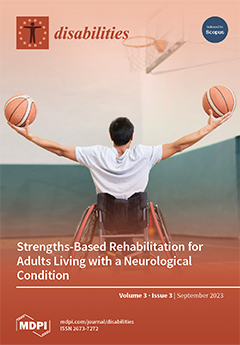Introduction: Rehabilitation practices that adopt a strengths-based perspective are known as transdisciplinary evidence-based practices. However, little is known about whether and how such a perspective is experienced by people living with a neurological condition during their rehabilitation.
Objective: To explore how
[...] Read more.
Introduction: Rehabilitation practices that adopt a strengths-based perspective are known as transdisciplinary evidence-based practices. However, little is known about whether and how such a perspective is experienced by people living with a neurological condition during their rehabilitation.
Objective: To explore how core components of a strengths-based rehabilitation perspective (i.e., hope, self-determination, and mobilization of personal strengths) are envisioned and experienced in outpatient-based rehabilitation by adults living with multiple sclerosis or spinal cord injury.
Methods: A descriptive exploratory study with mixed data collection was conducted with adults living with spinal cord injury (
n = 9) or multiple sclerosis (
n = 11). Participants completed two semi-structured interviews and the Recovery Promoting Relationship Scale (RPRS). The qualitative analysis relied on a hybrid inductive and deductive approach.
Results: Four themes depict a strengths-based rehabilitation perspective: (1) The mobilization of personal strengths (e.g., what a strengths-based perspective could offer); (2) hope (e.g., what hinders hope in rehabilitation); (3) accessing information for decision-making (e.g., navigating the system); and (4) exercising self-determination (e.g., influencing the length or intensity of rehabilitation services).
Conclusions: Hope, self-determination, and the mobilization of personal strengths are of the utmost importance throughout the rehabilitation of adults living with multiple sclerosis and or spinal cord injury. This paper raises awareness about elements specific to the contexts in which services are offered or to the therapeutic relationships influencing how these three strength-based constructs are envisioned and experienced in rehabilitation.
Full article





